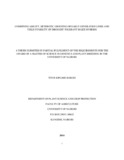| dc.description.abstract | Maize (Zea mays L) is an important food and feed crop in sub-Saharan Africa whose demand has continually increased pushing farmers to grow the crop in less suitable areas. Breeders have developed new germplasm that can withstand drought and other stresses offered by the variable environmental conditions on the farmers’ fields. The objectives of this study were to determine the general and specific combining abilities of the early generation materials, classify them into their heterotic groups and to determine yield stability of the new hybrids across different locations. In the first part of this study, one hundred and six selected early generation lines were crossed to two single cross testers (CML312 x CML 442 and CML395 x CML444) which belong to heterotic groups A and B respectively, and the results evaluated in 6 environments. In the second part, 46 new drought tolerant hybrids were evaluated across 17 environments. Good performing hybrids were identified on both the early generation hybrids and regional hybrid trials test varieties. Results also revealed significant differences (P < 0.001) for grain yield among early generation hybrids where entries 74, 25, 35 and 32 were identified as good performers at Kakamega, Kiboko and Embu trials. Entries 35, and 74 showed good performance across all environments, with entry 74 being the best yielder overall. Lines 1, 4, 14, 16 and 37 showed favourable and significant general combining ability (GCA) for grain yield in all sites,and across sites. In addition, line 37 showed significant and favourable GCA for days to anthesis anthesis to silking interval and gray leaf spot indicating that it was a potentially good parent in formation of new hybrids. Specific combining abilities for lines classified 55 lines into heterotic group B, and 51 lines into heterotic group A. Stability analysis using 6 models revealed entry 74 having above average performance and stability when all stability analysis models were used, but for ecovalence and stability variance measures. Entries 100, 126, 116 and 23 showed above average stability and yield performance across different locations, when Eberhart and Russell, and Finlay and Wilkinson were used. The GGE biplot technique provided a much better tool for analyzing genotype by environment interaction. Entries 27 and 74 (Early generation 3 way hybrids), and entries 29 and 42 (regional hybrids) were shown to be closest to the most ideal genotypes across all environments. The general, specific combining abilities and heterotic groups were determined and showed that these genotypes had potential hybrids for advanced yield testing and subsequent release. Stability analysis on the early generation hybrids and regional hybrids revealed entries that were stable across locations. | en_US |

